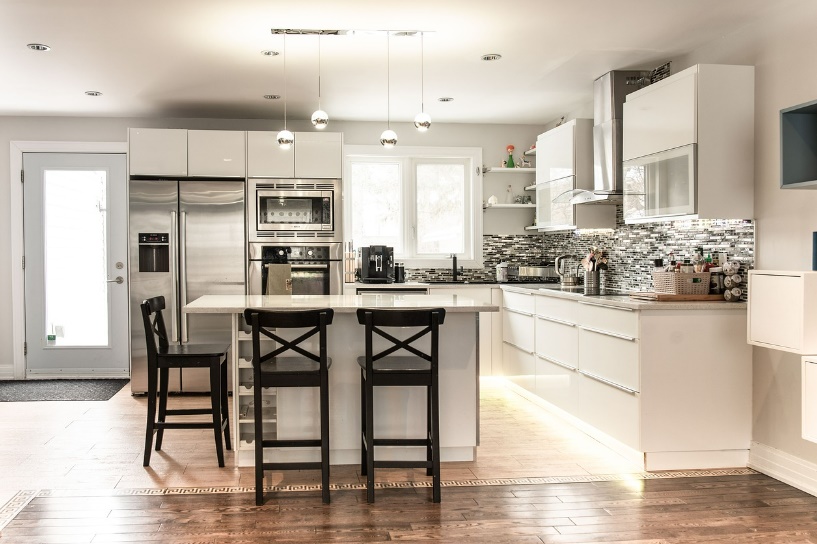Renovating your kitchen is not just about selecting the right countertops or appliances; it involves a bunch of decisions that can impact the functionality and aesthetics of your space. Homeowners often fall into common pitfalls that can turn a dream kitchen into a less than ideal reality.
Design mistakes, no matter how small, can disrupt the functionality of the space, lead to increased costs, or even necessitate further renovations down the line. Common issues range from inadequate lighting, which can create a dreary workspace, to poor layout choices that hinder movement and usability. We have listed many ideas for kitchen remodels in a previous post if you are looking for inspiration. With the kitchen acting as a multifunctional space that needs to cater to cooking, dining, and socializing, every aspect of its design must be carefully considered.
Understanding these challenges, this article aims to guide local homeowners or home builders through the process, highlighting common kitchen design mistakes and providing expert advice on how to avoid them. By arming yourself with knowledge and planning meticulously, you can create a kitchen that not only looks beautiful but also meets your needs and stands the test of time. Whether you’re embarking on a minor update or a major renovation, avoiding these pitfalls will ensure your kitchen is both functional and inviting, making your home more enjoyable and potentially increasing its value.
Poor Lighting
Lighting plays a pivotal role in the kitchen, affecting both its ambiance and usability. A common mistake is insufficient lighting, which can make cooking and food preparation challenging. Incorporating a mix of lighting types, including general, task, and accent lighting, can create a balanced and functional space. Task lighting is particularly important over work areas such as the stove and countertops to ensure safety and ease in food preparation.
Bad Ventilation
A well-ventilated kitchen is essential for removing cooking smells and preventing them from spreading throughout your home. An effective ventilation system not only helps maintain a fresh environment but also prolongs the lifespan of your appliances by reducing the heat and moisture levels. When planning your kitchen, include a high-quality range hood or exhaust fan to keep your space odor-free and comfortable.
Neglecting Trash Management
Kitchens generate a significant amount of waste, so it’s crucial to have a proper waste management system in place. This includes designated areas for garbage, recycling, and composting. Lack of planning in this aspect can lead to clutter and inconvenience. Integrating hidden bins within cabinetry or allocating a specific area for waste can help maintain cleanliness and organization.
Budgetary Oversights
Remodeling a kitchen can be expensive, and it’s easy to underestimate costs. Setting a realistic budget that includes a buffer for unexpected expenses is critical. On average, kitchen renovations should account for about 20% of your home’s value. Allocating funds across different areas such as appliances, cabinetry, and labor, while setting aside a contingency fund, can prevent financial strain and ensure your project stays on track.
Choosing Trend Over Timelessness
While it’s tempting to incorporate the latest design trends into your kitchen, they can quickly become outdated. Opting for classic and neutral designs for permanent fixtures ensures longevity. If you enjoy following trends, consider applying them to easily replaceable items like bar stools, light fixtures, or wall colors. This approach allows you to refresh your kitchen’s look without undergoing another major renovation.
Ineffective Layout
The layout is the backbone of your kitchen’s design. A common mistake is not considering the workflow, which can result in a cramped or inefficient space. The kitchen work triangle—comprising the sink, stove, and refrigerator—should be optimized for easy movement. Additionally, ensure there’s ample space for opening appliances and cabinets without obstruction.
Blocking Natural Light
Natural light can make your kitchen feel more open and welcoming. Unfortunately, some designs inadvertently block windows with kitchen cabinetry or appliances. Planning your layout to maximize natural light not only enhances aesthetics but also contributes to energy efficiency. Consider using light-colored materials and reflective surfaces to amplify the light in your kitchen.
Single Lighting Source
Relying on a single light source can create shadows and uneven lighting. A combination of overhead lighting, under-cabinet lights, and pendant lights can provide both functionality and ambiance. Each type serves a different purpose: general lighting illuminates the room, task lighting focuses on work areas, and accent lighting highlights architectural features or decor.
Unused Corner Spaces
Corner spaces are often underutilized in kitchen designs. Innovative solutions like carousel units or pull-out drawers can transform these areas into valuable storage. These solutions not only make use of every inch of your kitchen but also make accessing items more convenient, helping to keep your countertops clutter-free.
Lack of Pantry Space
A pantry is essential for storing groceries and kitchen essentials. Without adequate pantry space, keeping your kitchen organized can be challenging. If space allows, consider adding a walk-in pantry. For smaller kitchens, pull-out cabinets or wall-mounted shelving can serve as effective alternatives, ensuring everything has its place.
Inadequate Chimney Installation
Proper ventilation is vital, and a chimney or range hood is a must-have in any kitchen. It’s not enough to have windows or an exhaust fan; a chimney efficiently removes smoke, grease, and odors. Ensure your kitchen design includes a high-quality ventilation system positioned directly over your cooking area to maintain a clean and pleasant environment.
Avoiding these common mistakes can significantly improve the functionality, aesthetics, and overall satisfaction with your kitchen renovation. Remember, careful planning and consideration of every aspect of your kitchen’s design can lead to a space that’s not only beautiful but also practical and enjoyable to use for years to come.
Conclusion
Designing the ideal kitchen requires a careful balance of aesthetics, functionality, and foresight. As we’ve explored, there are numerous pitfalls that can easily ensnare someone, ranging from lighting missteps to ventilation oversights, each capable of turning a kitchen from a dream into a dilemma. Yet, armed with the knowledge of these common mistakes and guided by expert advice, homeowners can navigate these challenges with confidence. The goal is not just to create a kitchen that looks good in the here and now, but one that will continue to serve and inspire for years to come.
Remember, a successful kitchen design is one that reflects your personal style while also meeting your practical needs. It requires a blend of creativity and practicality, an eye for detail, and an understanding of your own lifestyle. By avoiding these common design mistakes, you’re not just investing in your home’s value; you’re investing in your daily joy and comfort. As you embark on this journey, take the time to plan, ponder, and personalize your space. After all, the best kitchens are those that bring people together.


